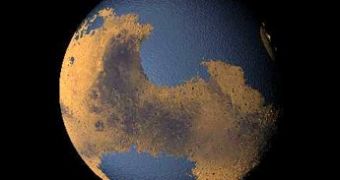It has been often implied, in the last decades, that Mars must have been warmer in its past, and was able to sustain temperatures well above the water's freezing point, in order to account for the incontestable evidence that suggests the presence of liquid water on its surface in the past. On Earth, carbon dioxide seems to produce a similar effect; however, scientists, driven by familiar processes, predicted that the same gas must have been responsible for the Martian greenhouse effect.
NASA's Martian rovers, Spirit and Opportunity, have been studying the surface of the Red Planet for more than four years, in order to find evidence to support the greenhouse effect theory but, so far, they have been unable to find a key marker in proving the presence of concentrated levels of carbon dioxide in the past. On Earth, carbon dioxide is mostly absorbed by carbon dioxide sinks and forms deposits of limestone and carbonate rocks, which apparently are missing from the Red Planet.
In order to resolve the paradox, scientists recently proposed another greenhouse gas which could be responsible for the global warming effect on Mars - sulfur dioxide. This could also explain why, although the volcanic activity on Mars should have produced significant carbon dioxide and hydrogen gas emissions, the carbonate rocks are not present on the surface. Sulfur dioxide, like carbon dioxide, is a powerful greenhouse gas, and it also determines a high acidity of ocean water, that prevents carbonate from forming.
Even though, carbon is one of the base elements required for life to appear. Scientists argue that a similar process could have been triggered on Mars, which did not depend entirely on the carbon-based chemistry, fact that could redefine the concept of habitable planet.
Computer models regarding the new theory show that Mars could have supported a habitat with temperatures above freezing point and liquid water for more than 500 million years, in a period of time when the Sun was not shining as bright as we see it today. Unlike Earth's atmosphere, Mars has no oxygen, thus it could have been maintained in the atmosphere for much longer, and would have eventually deposited on the surface in the form of sulfites, similar to those often found by both NASA's rovers, Spirit and Opportunity, and ESA's Mars Express.
The early Earth's atmosphere could have also had a large concentration of sulfur dioxide emitted by volcanoes in the past, but was quickly oxidized by the oxygen rich environment, forming acid rain that washed the carbonate deposits from the surface; however, the sulfur dioxide concentrations dropped about 2.5 to 4 billion years ago, after which carbonate deposits formed once again.
Due to the fact that evidence of carbon dioxide gas that would have caused the Martial greenhouse effect could not be found, similar research previously proposed other two greenhouses gases common on Earth, ammonia and methane.

 14 DAY TRIAL //
14 DAY TRIAL //